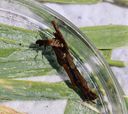Northern Caddisflies
Limnephilidae
Classification
- Phylum: Arthropoda
- Subphylum: Hexapoda
- Class: Insecta
- Order: Trichoptera
- Suborder: Integripalpia
- Infraorder: Plenitentoria
- Superfamily: Limnephiloidea
- Family: Limnephilidae
Pronunciation
How to pronounce Limnephilidae: //lɪmˌniːfɪˈlɪdiː//
These audio files are automatically generated. While they are not always 100% accurate, they are a good starting point.
Images






Summary
The Limnephilidae, known as northern caddisflies, are a diverse family of caddisflies primarily found in northern temperate regions. They are characterized by their unique larval cases and the life cycle that involves aquatic larvae and flying adults. Adults are typically brown, with distinctive wing structures and patterns.
Physical Characteristics
Adult body size ranges from 7-23 mm; ocelli present; maxillary palpi are 3-segmented in males and 5-segmented in females; wings are usually brown with mottling or stripes; antennae are typically as short as or shorter than wings. Larvae have antennae located midway between the bases of the mandibles and the eyes; the first abdominal tergite is humped; larval cases can be made from various materials including leaves, stems, moss, sand, bark, or snail shells.
Identification Tips
Look for the presence of ocelli in adults and the unique larval cases constructed from a variety of materials.
Habitat
Larvae inhabit slow-moving streams, ponds, and marshes; adults rest on vegetation near these habitats during the day.
Distribution
Found predominantly in northern temperate regions, with over 300 species reported in North America, including 44 species in Michigan.
Diet
Larvae primarily feed on algae by browsing or scavenging on animal remains.
Life Cycle
The life cycle is typically completed within one year for most species; larvae pupate within their cases and emerge as adults.
Reproduction
Mating occurs after adult emergence, with females laying eggs typically in or near water.
Ecosystem Role
Limnephilidae play a role in nutrient cycling and serve as an important food source for various predators such as fish and birds.
Collecting Methods
- Light trapping at night
- Collecting larvae from aquatic habitats
Preservation Methods
- Pinning adults for taxonomic study
- Preserving larvae in ethanol
Similar Taxa
Tags
- caddisflies
- Limnephilidae
- Trichoptera
- aquatic insects
- ecosystem